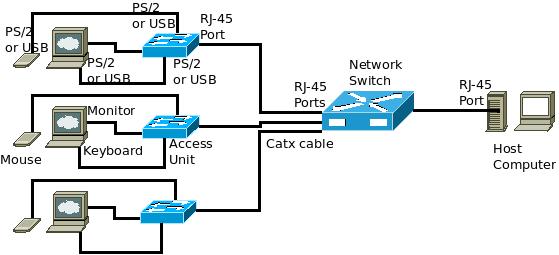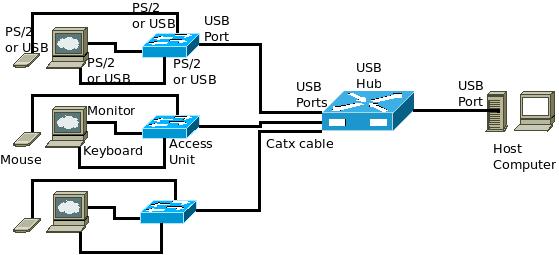Virtualize your desktop hardware – Create multiple desktops by adding monitor keyboard & mouse
There maybe certain situations (like school/ college labs) where a large number of computers are required but none of them would require a huge amount of processor/ memory capacity. In such situations, and when there is a budget constraint, it is possible to use just one computer to create ten or more computers by adding additional monitor, keyboard, mouse & low cost access/connectivity hardware devices. Read on, to find out more…

 Earlier, we looked at desktop virtualization where processing is done using powerful servers in the data center and only the image is sent to the desktop computers. This approach has a lot of advantages, but the primary disadvantage is the fact that either desktop computers (or) thin clients still needs to be purchased for all the users.
Earlier, we looked at desktop virtualization where processing is done using powerful servers in the data center and only the image is sent to the desktop computers. This approach has a lot of advantages, but the primary disadvantage is the fact that either desktop computers (or) thin clients still needs to be purchased for all the users.
But today, we’ll look at another way of virtualizing desktops, by sharing the processor/memory of a single desktop to create multiple desktops by just adding monitors, keyboard, mouse and low cost access devices for each user. The architecture for creating such shared desktops is shown in the above two diagrams.
In the first diagram, each virtualized desktop has an access unit (used instead of CPU) that connects to the network switch using RJ-45 ports, on one side and keyboard/mouse/monitor using common interfaces like PS/2, USB, VGA on the other side. On the right hand side, the network switch connects to a host computer (whose hardware is being shared to create multiple virtual computers). The second diagram is similar to the first, but instead of network switch / RJ-45 ports, all the connections are through a USB hub/ USB ports.
Of course, in both the cases, a desktop virtualization software is required on the host computer to coordinate the receiving of inputs/ sending of display images to the individual virtual desktops. So, when this set up is complete, any user working on any of the virtual desktop thinks that they are working on a dedicated computer while in actuality, the data is processed on the CPU of the host computer and only the output is shared to the virtual computers. And for this purpose, some specialized protocol might be employed to accelerate the display output. The files of the virtual desktops are stored in the host desktop.
Basically this works on the premise that the desktop computers available today with multi-core processors/ high capacity of RAM etc, are quite powerful and its huge amount of processor/ memory capacity is never fully utilized by a single desktop. So, that excess capacity can be shared – either with one more desktop user/ few more desktop users – depending on the load/ type of applications.
The access units in virtual desktops (used instead of CPU) contain low cost/ low power processor / memory for doing some basic level local processing and display rendering. These units connect the monitor/ keyboard/ mouse and in some cases even external USB based storage devices/ microphone/ speakers, etc. These units require additional power (low power like 5W) which can be given directly through an AC adapter or through the USB interface itself.
Advantages:
- The cost of the specialized access units (required for each virtual desktop) is considerably lesser than full fledged central processing units (CPU). So, there is cost reduction (CapEx) if a considerable quantity of desktops are required.
- The access devices use lesser power (when compared with full fledged CPU’s) and hence the power savings on total number of devices used (on the long run) reduces the operational expenses (OpEx).
- Simplified maintenance/ management as the number of desktops to be managed (physically) is reduced.
- More efficient utilization of the powerful processors/ RAM with shared desktops.
Limitations:
- The access units incur additional costs for each virtual desktop – in addition to the costs of the monitor, keyboard and mouse.
- Streaming video/ multimedia performance may not be as good as having individual desktops.
- If the main (host) desktop fails, all the virtual desktops attached to it would also not function.
- The operating system(s) that can be used on virtual desktops is limited, and determined by the desktop virtualization vendor.
- If windows is used, windows server/ MU license is required along with individual server user licenses. The desktop virtualization software would also incur a one time license cost.
You can have a look at desktop virtualization solutions from NComputing and Userful, to understand further on this topic.
excITingIP.com
You could stay up to date on the various computer networking/ related IT technologies by subscribing to this blog with your email address in the sidebar box that says, ‘Get email updates when new articles are published’
THANK YOU VERY MUCH FOR THESE VERY INFORMATIVE INFORMATION.
Thanks a whole lot…. how and where can i get the hardwares here in NIgeria.